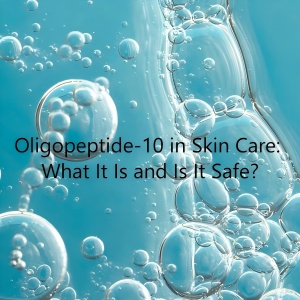Oligopeptide-10 in Skin Care: What It Is and Is It Safe?

Oligopeptide-10 is a synthetic peptide gaining attention in the skincare world, particularly for its role in addressing acne-prone skin. As consumers become more ingredient-savvy, understanding what Oligopeptide-10 does and whether it’s safe is essential for making informed skincare choices. This article dives into the science behind Oligopeptide-10, its benefits, safety profile, and how it fits into your skincare routine.
What Is Oligopeptide-10?
Oligopeptide-10 is a short-chain peptide composed of amino acids, designed to mimic natural biological processes in the skin. It is often used in skincare formulations for its antimicrobial and anti-inflammatory properties, making it particularly effective for acne-prone skin. Unlike larger proteins, oligopeptides are small enough to penetrate the skin’s surface, allowing them to interact with skin cells and provide targeted benefits.
Benefits of Oligopeptide-10 in Skin Care
Oligopeptide-10 is celebrated for its ability to combat acne-causing bacteria, specifically *Propionibacterium acnes* (*P. acnes*), which is a primary contributor to acne breakouts. By targeting this bacteria, Oligopeptide-10 helps reduce the occurrence of pimples and inflammation. Additionally, it supports the skin’s natural barrier, promoting a healthier complexion without causing irritation, making it suitable for sensitive skin types.
How Does Oligopeptide-10 Work?
The peptide works by disrupting the cell membranes of acne-causing bacteria, effectively neutralizing them. Its anti-inflammatory properties also help calm redness and swelling associated with breakouts. When combined with other ingredients like salicylic acid or niacinamide, Oligopeptide-10 can enhance the overall efficacy of acne-fighting products, providing a synergistic effect that tackles multiple aspects of acne formation.
Is Oligopeptide-10 Safe for Skin?
Oligopeptide-10 is considered safe for topical use in skincare products. It is non-irritating and well-tolerated by most skin types, including sensitive skin. Studies and clinical data suggest it poses minimal risk of adverse reactions when used as directed. However, as with any skincare ingredient, it’s wise to patch-test products containing Oligopeptide-10 to ensure compatibility with your skin, especially if you have a history of allergies or sensitivities.
How to Incorporate Oligopeptide-10 into Your Skincare Routine
Oligopeptide-10 is commonly found in serums, moisturizers, and spot treatments designed for acne-prone skin. To incorporate it into your routine, apply a product containing Oligopeptide-10 after cleansing and toning, but before heavier creams or sunscreens. For best results, use it consistently as part of a comprehensive skincare regimen that includes gentle cleansing, exfoliation, and sun protection.
Conclusion
Oligopeptide-10 is a promising ingredient for those seeking effective, science-backed solutions for acne-prone skin. Its antimicrobial and anti-inflammatory properties make it a valuable addition to skincare formulations, and its safety profile ensures it’s suitable for a wide range of users. By understanding how Oligopeptide-10 works and incorporating it into your routine, you can take a proactive step toward clearer, healthier skin.


